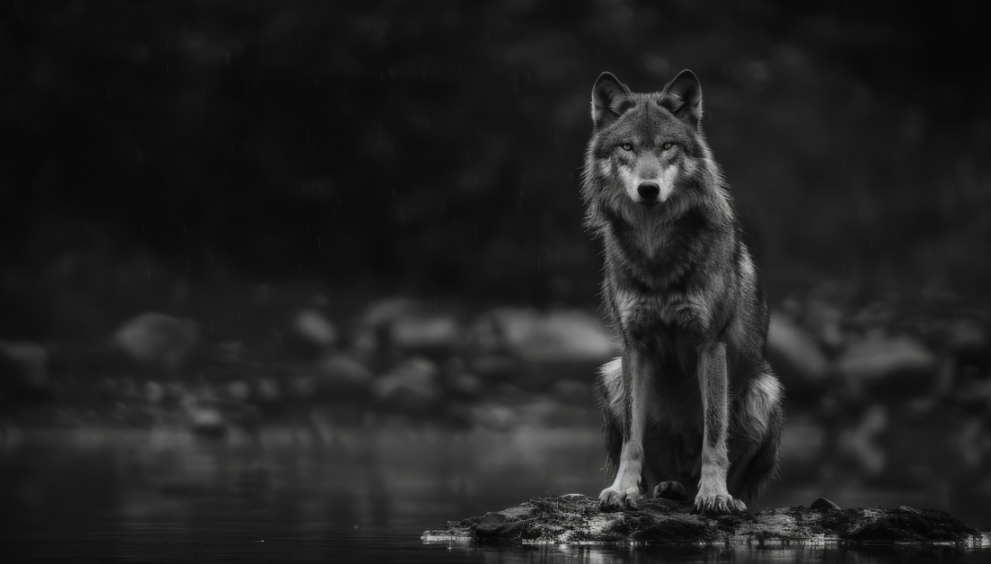The Mystique of the Black Coyote: A Rare Glimpse into Nature’s Enigma

The natural world is filled with creatures that capture the imagination, each with its unique place in the ecosystem. Among these, the black coyote stands out as a rare and mysterious figure, often shrouded in myth and misunderstanding. Unlike the more common gray or brown coyote, the black coyote’s striking appearance makes it an anomaly in the wild, leading to a blend of admiration, curiosity, and fear.
This article delves deep into the world of the black coyote, exploring its origins, behavior, significance in different cultures, and the myths that surround it. By the end of this exploration, you’ll have a comprehensive understanding of this fascinating creature, why it’s so rare, and what it symbolizes in the grand tapestry of nature.
1. The Origins of the Black Coyote: A Genetic Rarity:
The black coyote is not a distinct species but rather a color variation of the common coyote (Canis latrans). The black fur of these coyotes is the result of a genetic mutation known as melanism.
Genetic Background: Melanism in coyotes is a result of a recessive allele, meaning that both parents must carry the gene for their offspring to potentially have black fur. This gene is relatively rare among coyotes, which is why black coyotes are uncommon. The gene responsible for melanism in coyotes is believed to have been inherited from domestic dogs that interbred with coyotes thousands of years ago.
Prevalence: Black coyotes are more commonly found in the southeastern United States, particularly in areas where coyotes and domestic dogs historically interbred. While they can also be found in other regions, their rarity makes each sighting a unique event.
2. Physical Characteristics: The Beauty and Strength of the Black Coyote:
At first glance, the black coyote may appear similar to a domestic dog due to its dark fur, but a closer look reveals distinct features typical of wild coyotes. These include:
- Size and Build: Black coyotes are generally the same size as their more common counterparts, weighing between 20 to 50 pounds and standing about 24 inches at the shoulder. They have a lean, agile build that makes them excellent hunters.
- Fur and Coloration: The most striking feature is, of course, their black fur. However, not all black coyotes are completely black; some have patches of lighter fur, particularly on their underbellies and legs.
- Eyes: Like other coyotes, black coyotes typically have yellow or amber eyes, which add to their piercing, wild appearance.
- Tail: Their tails are bushy and often carried low, with the tip sometimes appearing darker than the rest of the body.
3. Behavioral Traits: The Cunning and Adaptability of the Black Coyote:
Coyotes, regardless of their color, are known for their cunning and adaptability. These traits have allowed them to thrive in a variety of environments, from dense forests to urban areas. The black coyote shares these characteristics, with some subtle differences:
- Hunting and Diet: Coyotes are opportunistic feeders, and black coyotes are no exception. They hunt small mammals, birds, and reptiles and are also known to scavenge for food. In urban areas, they may forage in trash cans or prey on domestic animals, leading to frequent conflicts with humans.
- Social Structure: Coyotes are generally solitary hunters, but they also form loose family groups, especially during the breeding season. Black coyotes are often seen alone, though they may be part of a larger pack that is less visible.
- Territorial Behavior: Coyotes are highly territorial animals. The black coyote’s dark fur may give it an advantage in certain environments, such as dense forests, where it can blend into the shadows more easily, making it a more effective hunter.
- Communication: Coyotes are known for their vocalizations, including howls, yips, and barks. These sounds serve to communicate with other coyotes and to establish territory.
4. The Cultural Significance of the Black Coyote:
The black coyote has played a significant role in the folklore and mythology of various cultures, particularly among Native American tribes. In many traditions, the coyote is seen as a trickster figure, a creature that embodies cunning and survival. The black coyote, with its rare and striking appearance, often takes on an even more symbolic role:
- Native American Mythology: In some Native American cultures, the black coyote is seen as a messenger or a harbinger of change. Its dark color is associated with the unknown, making it a creature of mystery and power. Some tribes believe that encountering a black coyote is a sign of a significant transformation or challenge ahead.
- Modern Interpretations: In today’s culture, the black coyote symbolizes resilience and adaptability, reflecting the ability to thrive amid change. It represents survival and thriving despite adversity.
- Folklore and Superstition: Throughout history, black animals have often been associated with bad omens or witchcraft. The black coyote, with its eerie howls and nocturnal habits, has sometimes been linked to such superstitions. However, many also view it as a guardian of the wilderness, a creature that watches over the natural world.
5. Human Interaction: Coexistence and Conflict:
The presence of black coyotes in areas inhabited by humans has led to a complex relationship between the two. While some view these animals with awe and respect, others see them as pests or threats. This section explores the different facets of human interaction with black coyotes:
- Conservation Status: Coyotes, in general, are not considered endangered, and their populations have remained stable or even increased in some areas. However, the black coyote, due to its rarity, is often the subject of interest for wildlife enthusiasts and conservationists. Protecting their habitats ensures that this unique genetic variation continues to thrive.
- Urban Encounters: As human populations expand into previously wild areas, encounters with black coyotes have become more common. These encounters can be thrilling but also dangerous, especially when coyotes lose their natural fear of humans. Educating communities about how to coexist with coyotes can help reduce conflicts.
- Hunting and Trapping: In some regions, coyotes are hunted or trapped due to their perceived threat to livestock or pets. Black coyotes, with their rare fur, may be particularly targeted by hunters.
6. The Myths and Legends Surrounding the Black Coyote:
The black coyote has inspired a variety of myths and legends over the years. These stories often reflect the fears, hopes, and values of the cultures that created them. Understanding these myths can provide insight into how humans have historically viewed this enigmatic creature:
- The Shape-shifter: One common myth is that black coyotes are shape-shifters, able to transform into human form or other animals. This belief is rooted in the idea that the coyote is a trickster, a being that can change its shape to deceive or teach lessons to humans.
- The Lone Wanderer: In some stories, the black coyote is depicted as a lone wanderer, a creature that roams the wilderness alone. This image symbolizes independence and the ability to survive without relying on others, traits that are often admired in these tales.
- The Guardian of the Night: Another legend portrays the black coyote as a guardian of the night, a protector of the wilderness that ensures the balance of nature. This myth highlights the importance of coyotes in the ecosystem and their role in maintaining the natural order.
7. Black Coyotes in Pop Culture: From Folklore to Media:
The black coyote’s enigmatic nature has made it popular in media, from literature to TV. This section examines its representation in pop culture and what these portrayals reveal about society’s views on this rare animal:
- Literature and Art: The black coyote has appeared in numerous works of literature and art, often as a symbol of the wild and untamed aspects of nature. Artists and writers use the black coyote to evoke a sense of mystery and to explore themes of survival and adaptation.
- Film and Television: In film and television, the black coyote is sometimes depicted as a menacing figure, a creature that lurks in the shadows and represents the unknown dangers of the wild. However, other portrayals emphasize its intelligence and cunning, making it a more sympathetic character.
- Symbolism in Modern Culture: Today, the black coyote continues to be a symbol of resilience and adaptability. It represents the ability to thrive in challenging environments, a trait that resonates with people facing difficulties in their own lives.







